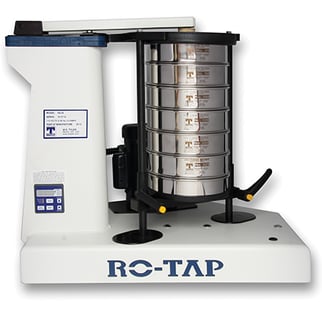RO-TAP® Mechanical Sieve Shaker: Performance Testing
In the world of particle size analysis, RO-TAP® products have gained a reputation for being reliable and long-lasting sieve shakers. The W.S. Tyler RO-TAP RX-29 and RX-30, in particular, have even been written into dozens of industry standards as tried and true particle size analysis equipment.
But as with any device that employs several moving parts, various elements of the RO-TAP may shift or displace from their original position. This, in turn, may affect performance and, more importantly, your results.
Having said that, how should you test your RO-TAP to ensure it maintains the quality test sieve analysis performance you depend on?
W.S. Tyler established the RO-TAP product line in 1914 and has the know-how needed to help your device perform as intended for years to come.
And with that, this article was written to establish some tips and tricks you can use to have your device performing to spec. It will cover:
- What a RO-TAP mechanical sieve shaker is
- Whether or not you need to calibrate your device
- How to test the performance of your RO-TAP Sieve Shaker
- The importance of testing the performance of your RO-TAP device
What Is the RO-TAP Mechanical Sieve Shaker?

The W.S. Tyler RO-TAP, specifically the RX-29 and RX-30 models, are mechanical sieve shakers that combine an oscillating motion with brute force hammer taps to agitate a test sieve stack. This, in turn, helps the individual particles of a material sample find the mesh openings of the sieves in the stack.
Do I Need to Calibrate My Device?
There are no standards documented that dictate the performance of either the RX-29 or RX-30. So when lab technicians ask if they should calibrate their device, how do they calibrate their device, or if we can calibrate their device, we explain that there is no standard to calibrate it to.
There are, however, performance specifications that provide insight into the intended performance of these mechanical sieve shakers. These specifications include:
- 278 +/- 10 oscillations per minute
- An oscillation displacement of 1-1/8" x 7/16"
- 150 +/- 5 hammer taps per minute
- A hammer weight of 5 lbs.6 oz.
- A NEMA Nom. Eff. 64 / P.F. 61 1725 RPMs electric motor rating
How Do I Test the Performance of My Device?
Of the listed performance specifications, the number of oscillations and hammer taps are easily testable. In fact, there are simple equations that you can use to test a RO-TAP's performance in-house.
To test the amount of oscillations per minute, count the oscillations of the device for 10 seconds and multiply that count by six.
Testing the hammer taps per minute is very similar. Simply count the amount of hammer taps that occur in 10 seconds and multiply that number by six.
For those who want to test the RPMs of the device, start by locating the small plastic disc with the reflective tape attached to the main shaft bolt at the bottom of the RO-TAP device. You then want to run the device while pointing a tachometer at the reflective tap to get a reading of the main shaft RPM.
The tachometer will measure how much the device moves in a minute and verify the motor's RPMs.
NOTE: There are dozens of mechanical sieve shakers on the market. The performance will vary from manufacturer to manufacturer.
Why Do I Need To Test the Performance of My Device?
If you fail to conduct performance maintenance based on performance testing, you will find your device not performing as intended over time. This will eventually result in inconsistent and unreliable sieve analysis data that will deviate progressively.
Now, as most performance issues can be traced back to a specific part, failure to test the performance of your device will make it hard to identify and replace worn parts. Using worn parts for prolonged periods of time will cause the whole tower to move around.
This will subsequently cause other parts within the device to wear down at an accelerated rate.
Replace Worn Parts To Maintain Accurate and Repeatable Results
The RO-TAP RX-29 and RX-30 are mechanical sieve shakers that, contrary to popular belief, cannot be calibrated. Instead, they can be tested and fine-tuned in accordance with designated performance specifications.
While we covered the ways you can test and verify the performance of your RO-TAP mechanical sieve shaker, there are instances in which dips in performance can't be fine-tuned. When this occurs, you will most likely need to replace worn parts to get your device back to peak performance.
As the creators of the original RO-TAP devices, W.S. Tyler strives to help lab technicians remove the roadblocks in their lab to make way for seamless results as accurate and reliable as their equipment.
To gain insight into the RO-TAP parts that commonly wear over time and how you can easily replace them in-house, review the following article:
About Ronnie Brown
Ronnie is the Content Writer for W.S. Tyler and has four years of experience as a professional writer. He strives to expand his knowledge on all things particle analysis and woven wire mesh to leverage his exceptional writing and graphic design skills, creating a one-of-a-kind experience for customers.




